Stroke Rehabilitation Needs: A Critical Review and Application
VerifiedAdded on 2023/06/11
|8
|1958
|186
Literature Review
AI Summary
This paper critically appraises a study on stroke rehabilitation needs, focusing on the perceptions of stroke patients and their caregivers. The review utilizes the Greenhalgh et al. model to assess the study's authorship, research questions, design, methodology, and results. The original study employed a mixed-methods approach to investigate the relationship between perceived rehabilitation needs and factors like age, stroke severity, and sense of coherence. The review identifies limitations such as a small sample size and potential biases in data collection. It also discusses barriers to implementing evidence-based practices in stroke rehabilitation, including organizational obstacles, lack of awareness among professionals, and the complexity of stroke care. The review concludes that while the original study has valuable insights, addressing the identified limitations is crucial for improving stroke rehabilitation practices. Desklib offers a variety of solved assignments and study resources for students.
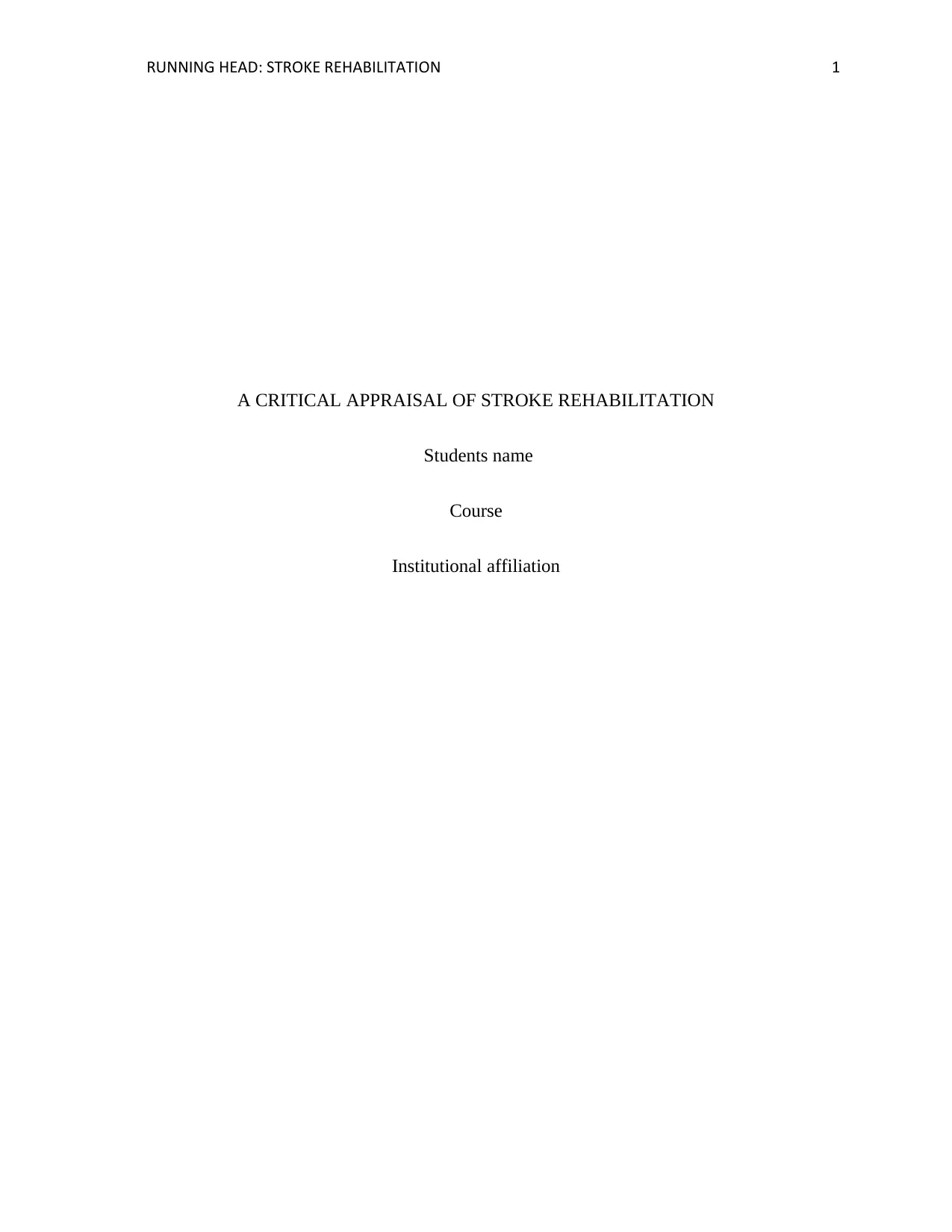
RUNNING HEAD: STROKE REHABILITATION 1
A CRITICAL APPRAISAL OF STROKE REHABILITATION
Students name
Course
Institutional affiliation
A CRITICAL APPRAISAL OF STROKE REHABILITATION
Students name
Course
Institutional affiliation
Paraphrase This Document
Need a fresh take? Get an instant paraphrase of this document with our AI Paraphraser
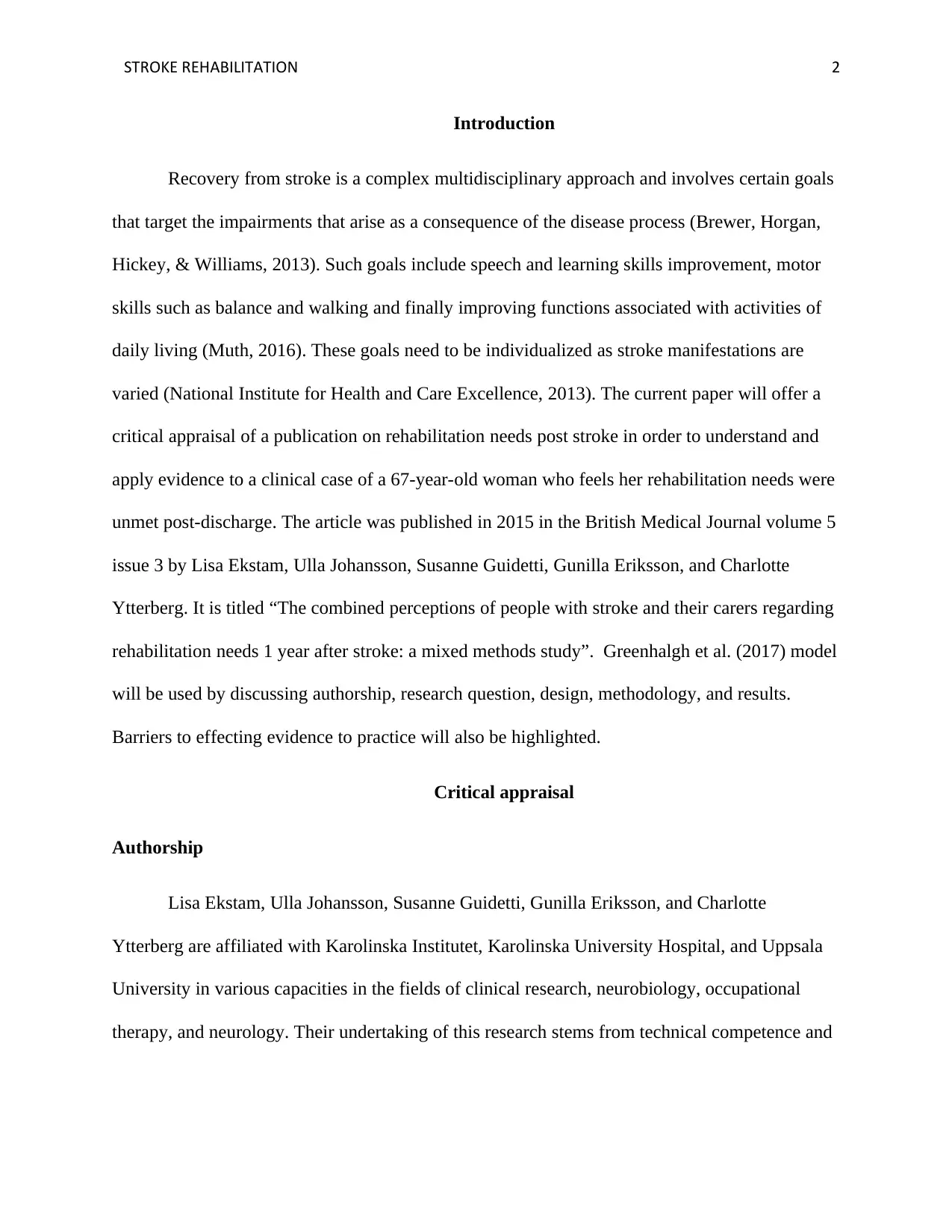
STROKE REHABILITATION 2
Introduction
Recovery from stroke is a complex multidisciplinary approach and involves certain goals
that target the impairments that arise as a consequence of the disease process (Brewer, Horgan,
Hickey, & Williams, 2013). Such goals include speech and learning skills improvement, motor
skills such as balance and walking and finally improving functions associated with activities of
daily living (Muth, 2016). These goals need to be individualized as stroke manifestations are
varied (National Institute for Health and Care Excellence, 2013). The current paper will offer a
critical appraisal of a publication on rehabilitation needs post stroke in order to understand and
apply evidence to a clinical case of a 67-year-old woman who feels her rehabilitation needs were
unmet post-discharge. The article was published in 2015 in the British Medical Journal volume 5
issue 3 by Lisa Ekstam, Ulla Johansson, Susanne Guidetti, Gunilla Eriksson, and Charlotte
Ytterberg. It is titled “The combined perceptions of people with stroke and their carers regarding
rehabilitation needs 1 year after stroke: a mixed methods study”. Greenhalgh et al. (2017) model
will be used by discussing authorship, research question, design, methodology, and results.
Barriers to effecting evidence to practice will also be highlighted.
Critical appraisal
Authorship
Lisa Ekstam, Ulla Johansson, Susanne Guidetti, Gunilla Eriksson, and Charlotte
Ytterberg are affiliated with Karolinska Institutet, Karolinska University Hospital, and Uppsala
University in various capacities in the fields of clinical research, neurobiology, occupational
therapy, and neurology. Their undertaking of this research stems from technical competence and
Introduction
Recovery from stroke is a complex multidisciplinary approach and involves certain goals
that target the impairments that arise as a consequence of the disease process (Brewer, Horgan,
Hickey, & Williams, 2013). Such goals include speech and learning skills improvement, motor
skills such as balance and walking and finally improving functions associated with activities of
daily living (Muth, 2016). These goals need to be individualized as stroke manifestations are
varied (National Institute for Health and Care Excellence, 2013). The current paper will offer a
critical appraisal of a publication on rehabilitation needs post stroke in order to understand and
apply evidence to a clinical case of a 67-year-old woman who feels her rehabilitation needs were
unmet post-discharge. The article was published in 2015 in the British Medical Journal volume 5
issue 3 by Lisa Ekstam, Ulla Johansson, Susanne Guidetti, Gunilla Eriksson, and Charlotte
Ytterberg. It is titled “The combined perceptions of people with stroke and their carers regarding
rehabilitation needs 1 year after stroke: a mixed methods study”. Greenhalgh et al. (2017) model
will be used by discussing authorship, research question, design, methodology, and results.
Barriers to effecting evidence to practice will also be highlighted.
Critical appraisal
Authorship
Lisa Ekstam, Ulla Johansson, Susanne Guidetti, Gunilla Eriksson, and Charlotte
Ytterberg are affiliated with Karolinska Institutet, Karolinska University Hospital, and Uppsala
University in various capacities in the fields of clinical research, neurobiology, occupational
therapy, and neurology. Their undertaking of this research stems from technical competence and
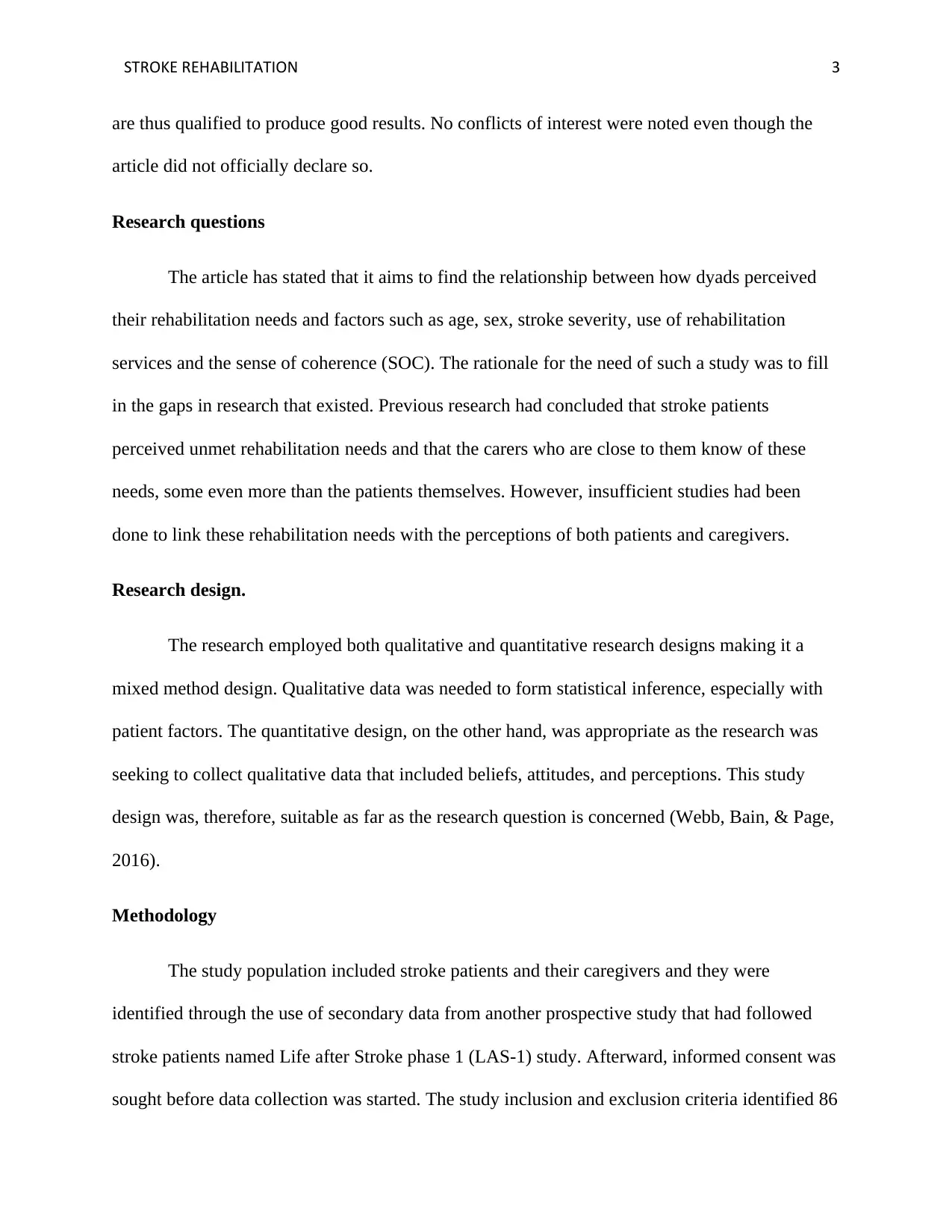
STROKE REHABILITATION 3
are thus qualified to produce good results. No conflicts of interest were noted even though the
article did not officially declare so.
Research questions
The article has stated that it aims to find the relationship between how dyads perceived
their rehabilitation needs and factors such as age, sex, stroke severity, use of rehabilitation
services and the sense of coherence (SOC). The rationale for the need of such a study was to fill
in the gaps in research that existed. Previous research had concluded that stroke patients
perceived unmet rehabilitation needs and that the carers who are close to them know of these
needs, some even more than the patients themselves. However, insufficient studies had been
done to link these rehabilitation needs with the perceptions of both patients and caregivers.
Research design.
The research employed both qualitative and quantitative research designs making it a
mixed method design. Qualitative data was needed to form statistical inference, especially with
patient factors. The quantitative design, on the other hand, was appropriate as the research was
seeking to collect qualitative data that included beliefs, attitudes, and perceptions. This study
design was, therefore, suitable as far as the research question is concerned (Webb, Bain, & Page,
2016).
Methodology
The study population included stroke patients and their caregivers and they were
identified through the use of secondary data from another prospective study that had followed
stroke patients named Life after Stroke phase 1 (LAS-1) study. Afterward, informed consent was
sought before data collection was started. The study inclusion and exclusion criteria identified 86
are thus qualified to produce good results. No conflicts of interest were noted even though the
article did not officially declare so.
Research questions
The article has stated that it aims to find the relationship between how dyads perceived
their rehabilitation needs and factors such as age, sex, stroke severity, use of rehabilitation
services and the sense of coherence (SOC). The rationale for the need of such a study was to fill
in the gaps in research that existed. Previous research had concluded that stroke patients
perceived unmet rehabilitation needs and that the carers who are close to them know of these
needs, some even more than the patients themselves. However, insufficient studies had been
done to link these rehabilitation needs with the perceptions of both patients and caregivers.
Research design.
The research employed both qualitative and quantitative research designs making it a
mixed method design. Qualitative data was needed to form statistical inference, especially with
patient factors. The quantitative design, on the other hand, was appropriate as the research was
seeking to collect qualitative data that included beliefs, attitudes, and perceptions. This study
design was, therefore, suitable as far as the research question is concerned (Webb, Bain, & Page,
2016).
Methodology
The study population included stroke patients and their caregivers and they were
identified through the use of secondary data from another prospective study that had followed
stroke patients named Life after Stroke phase 1 (LAS-1) study. Afterward, informed consent was
sought before data collection was started. The study inclusion and exclusion criteria identified 86
⊘ This is a preview!⊘
Do you want full access?
Subscribe today to unlock all pages.

Trusted by 1+ million students worldwide
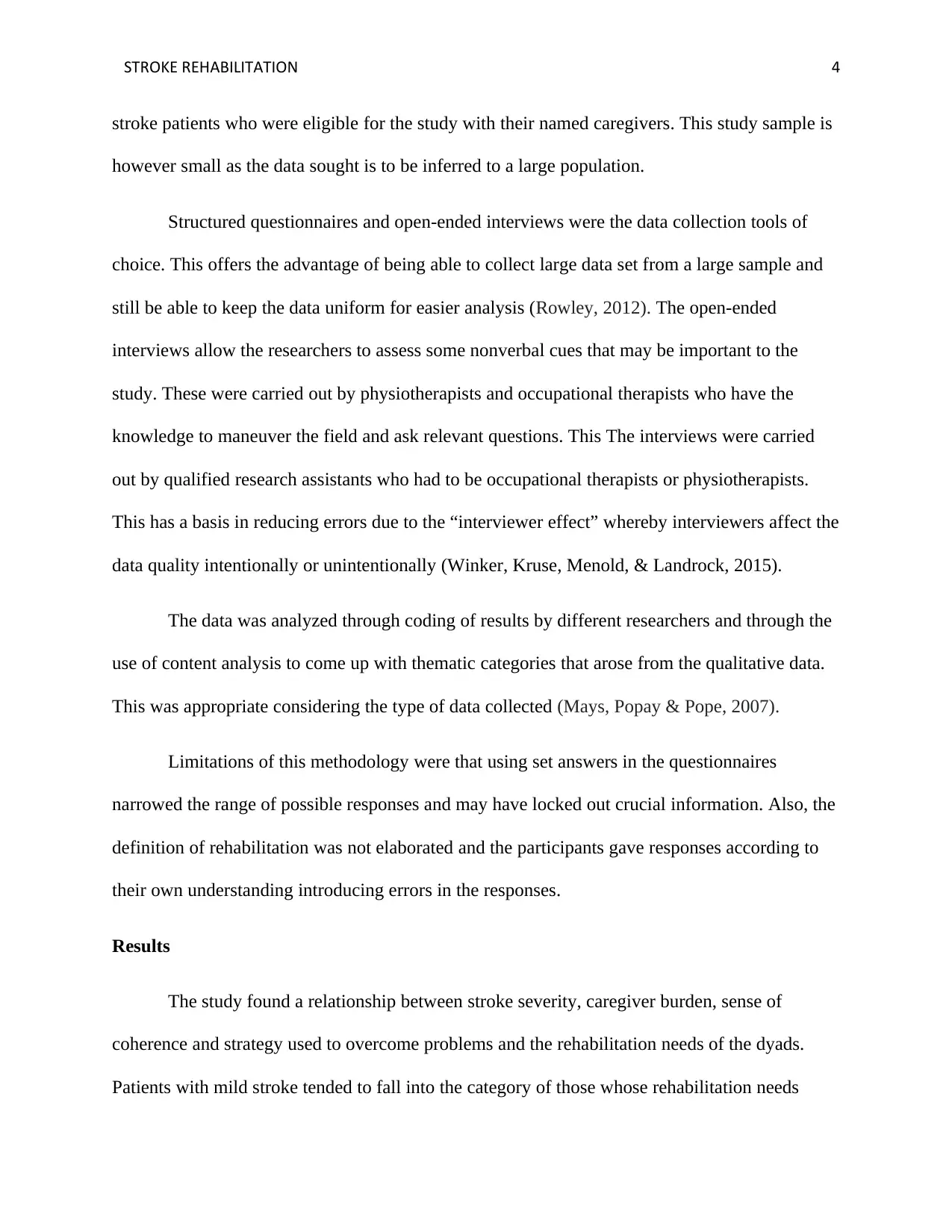
STROKE REHABILITATION 4
stroke patients who were eligible for the study with their named caregivers. This study sample is
however small as the data sought is to be inferred to a large population.
Structured questionnaires and open-ended interviews were the data collection tools of
choice. This offers the advantage of being able to collect large data set from a large sample and
still be able to keep the data uniform for easier analysis (Rowley, 2012). The open-ended
interviews allow the researchers to assess some nonverbal cues that may be important to the
study. These were carried out by physiotherapists and occupational therapists who have the
knowledge to maneuver the field and ask relevant questions. This The interviews were carried
out by qualified research assistants who had to be occupational therapists or physiotherapists.
This has a basis in reducing errors due to the “interviewer effect” whereby interviewers affect the
data quality intentionally or unintentionally (Winker, Kruse, Menold, & Landrock, 2015).
The data was analyzed through coding of results by different researchers and through the
use of content analysis to come up with thematic categories that arose from the qualitative data.
This was appropriate considering the type of data collected (Mays, Popay & Pope, 2007).
Limitations of this methodology were that using set answers in the questionnaires
narrowed the range of possible responses and may have locked out crucial information. Also, the
definition of rehabilitation was not elaborated and the participants gave responses according to
their own understanding introducing errors in the responses.
Results
The study found a relationship between stroke severity, caregiver burden, sense of
coherence and strategy used to overcome problems and the rehabilitation needs of the dyads.
Patients with mild stroke tended to fall into the category of those whose rehabilitation needs
stroke patients who were eligible for the study with their named caregivers. This study sample is
however small as the data sought is to be inferred to a large population.
Structured questionnaires and open-ended interviews were the data collection tools of
choice. This offers the advantage of being able to collect large data set from a large sample and
still be able to keep the data uniform for easier analysis (Rowley, 2012). The open-ended
interviews allow the researchers to assess some nonverbal cues that may be important to the
study. These were carried out by physiotherapists and occupational therapists who have the
knowledge to maneuver the field and ask relevant questions. This The interviews were carried
out by qualified research assistants who had to be occupational therapists or physiotherapists.
This has a basis in reducing errors due to the “interviewer effect” whereby interviewers affect the
data quality intentionally or unintentionally (Winker, Kruse, Menold, & Landrock, 2015).
The data was analyzed through coding of results by different researchers and through the
use of content analysis to come up with thematic categories that arose from the qualitative data.
This was appropriate considering the type of data collected (Mays, Popay & Pope, 2007).
Limitations of this methodology were that using set answers in the questionnaires
narrowed the range of possible responses and may have locked out crucial information. Also, the
definition of rehabilitation was not elaborated and the participants gave responses according to
their own understanding introducing errors in the responses.
Results
The study found a relationship between stroke severity, caregiver burden, sense of
coherence and strategy used to overcome problems and the rehabilitation needs of the dyads.
Patients with mild stroke tended to fall into the category of those whose rehabilitation needs
Paraphrase This Document
Need a fresh take? Get an instant paraphrase of this document with our AI Paraphraser
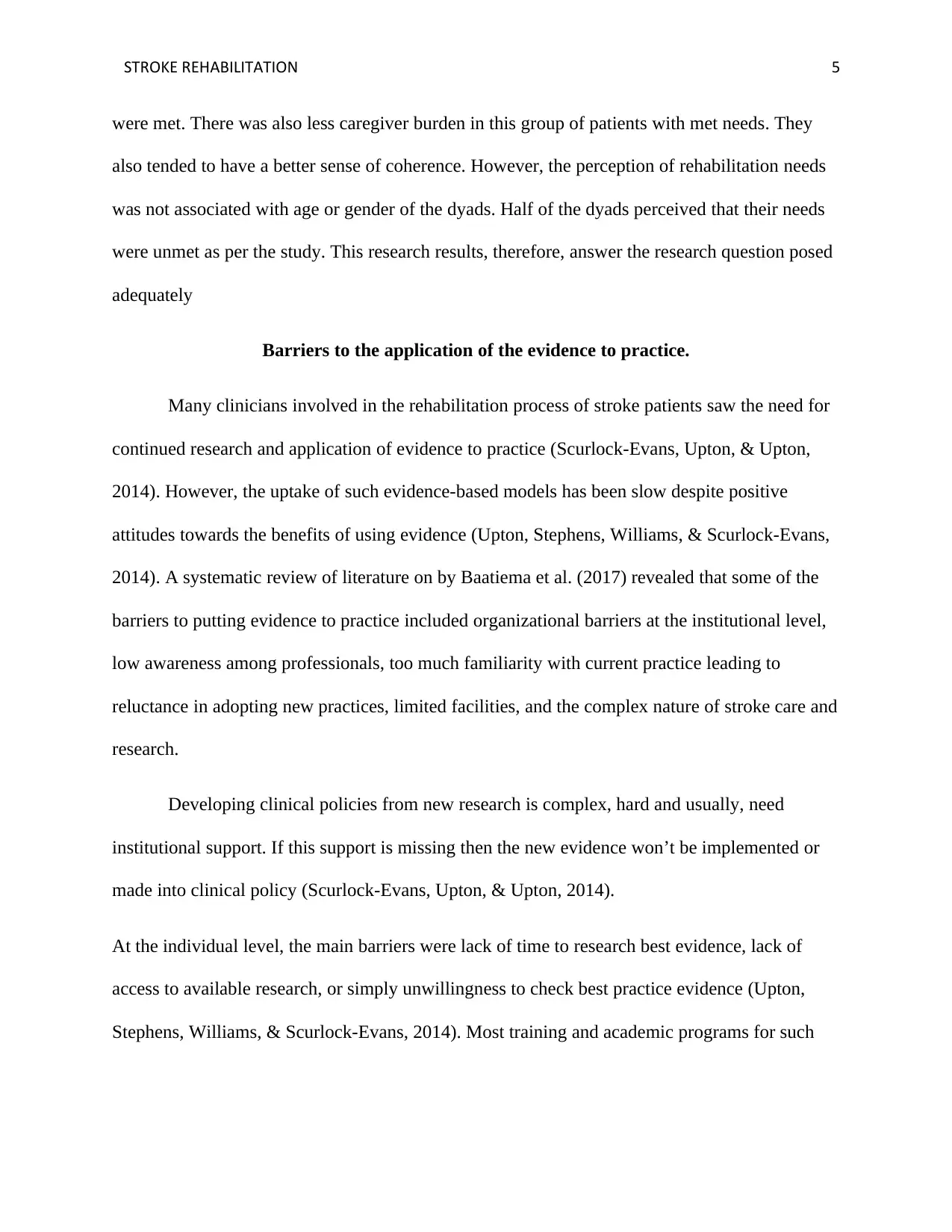
STROKE REHABILITATION 5
were met. There was also less caregiver burden in this group of patients with met needs. They
also tended to have a better sense of coherence. However, the perception of rehabilitation needs
was not associated with age or gender of the dyads. Half of the dyads perceived that their needs
were unmet as per the study. This research results, therefore, answer the research question posed
adequately
Barriers to the application of the evidence to practice.
Many clinicians involved in the rehabilitation process of stroke patients saw the need for
continued research and application of evidence to practice (Scurlock-Evans, Upton, & Upton,
2014). However, the uptake of such evidence-based models has been slow despite positive
attitudes towards the benefits of using evidence (Upton, Stephens, Williams, & Scurlock-Evans,
2014). A systematic review of literature on by Baatiema et al. (2017) revealed that some of the
barriers to putting evidence to practice included organizational barriers at the institutional level,
low awareness among professionals, too much familiarity with current practice leading to
reluctance in adopting new practices, limited facilities, and the complex nature of stroke care and
research.
Developing clinical policies from new research is complex, hard and usually, need
institutional support. If this support is missing then the new evidence won’t be implemented or
made into clinical policy (Scurlock-Evans, Upton, & Upton, 2014).
At the individual level, the main barriers were lack of time to research best evidence, lack of
access to available research, or simply unwillingness to check best practice evidence (Upton,
Stephens, Williams, & Scurlock-Evans, 2014). Most training and academic programs for such
were met. There was also less caregiver burden in this group of patients with met needs. They
also tended to have a better sense of coherence. However, the perception of rehabilitation needs
was not associated with age or gender of the dyads. Half of the dyads perceived that their needs
were unmet as per the study. This research results, therefore, answer the research question posed
adequately
Barriers to the application of the evidence to practice.
Many clinicians involved in the rehabilitation process of stroke patients saw the need for
continued research and application of evidence to practice (Scurlock-Evans, Upton, & Upton,
2014). However, the uptake of such evidence-based models has been slow despite positive
attitudes towards the benefits of using evidence (Upton, Stephens, Williams, & Scurlock-Evans,
2014). A systematic review of literature on by Baatiema et al. (2017) revealed that some of the
barriers to putting evidence to practice included organizational barriers at the institutional level,
low awareness among professionals, too much familiarity with current practice leading to
reluctance in adopting new practices, limited facilities, and the complex nature of stroke care and
research.
Developing clinical policies from new research is complex, hard and usually, need
institutional support. If this support is missing then the new evidence won’t be implemented or
made into clinical policy (Scurlock-Evans, Upton, & Upton, 2014).
At the individual level, the main barriers were lack of time to research best evidence, lack of
access to available research, or simply unwillingness to check best practice evidence (Upton,
Stephens, Williams, & Scurlock-Evans, 2014). Most training and academic programs for such
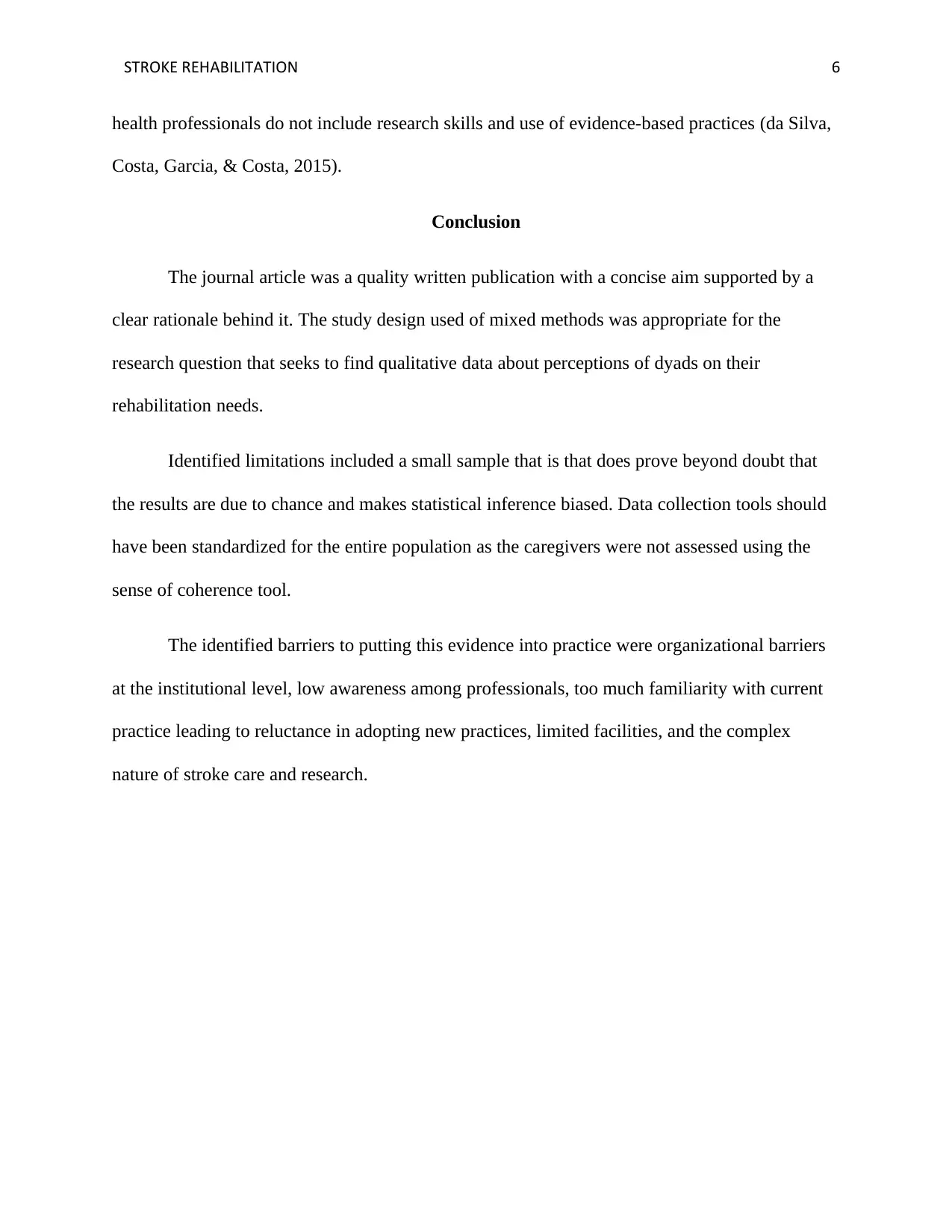
STROKE REHABILITATION 6
health professionals do not include research skills and use of evidence-based practices (da Silva,
Costa, Garcia, & Costa, 2015).
Conclusion
The journal article was a quality written publication with a concise aim supported by a
clear rationale behind it. The study design used of mixed methods was appropriate for the
research question that seeks to find qualitative data about perceptions of dyads on their
rehabilitation needs.
Identified limitations included a small sample that is that does prove beyond doubt that
the results are due to chance and makes statistical inference biased. Data collection tools should
have been standardized for the entire population as the caregivers were not assessed using the
sense of coherence tool.
The identified barriers to putting this evidence into practice were organizational barriers
at the institutional level, low awareness among professionals, too much familiarity with current
practice leading to reluctance in adopting new practices, limited facilities, and the complex
nature of stroke care and research.
health professionals do not include research skills and use of evidence-based practices (da Silva,
Costa, Garcia, & Costa, 2015).
Conclusion
The journal article was a quality written publication with a concise aim supported by a
clear rationale behind it. The study design used of mixed methods was appropriate for the
research question that seeks to find qualitative data about perceptions of dyads on their
rehabilitation needs.
Identified limitations included a small sample that is that does prove beyond doubt that
the results are due to chance and makes statistical inference biased. Data collection tools should
have been standardized for the entire population as the caregivers were not assessed using the
sense of coherence tool.
The identified barriers to putting this evidence into practice were organizational barriers
at the institutional level, low awareness among professionals, too much familiarity with current
practice leading to reluctance in adopting new practices, limited facilities, and the complex
nature of stroke care and research.
⊘ This is a preview!⊘
Do you want full access?
Subscribe today to unlock all pages.

Trusted by 1+ million students worldwide
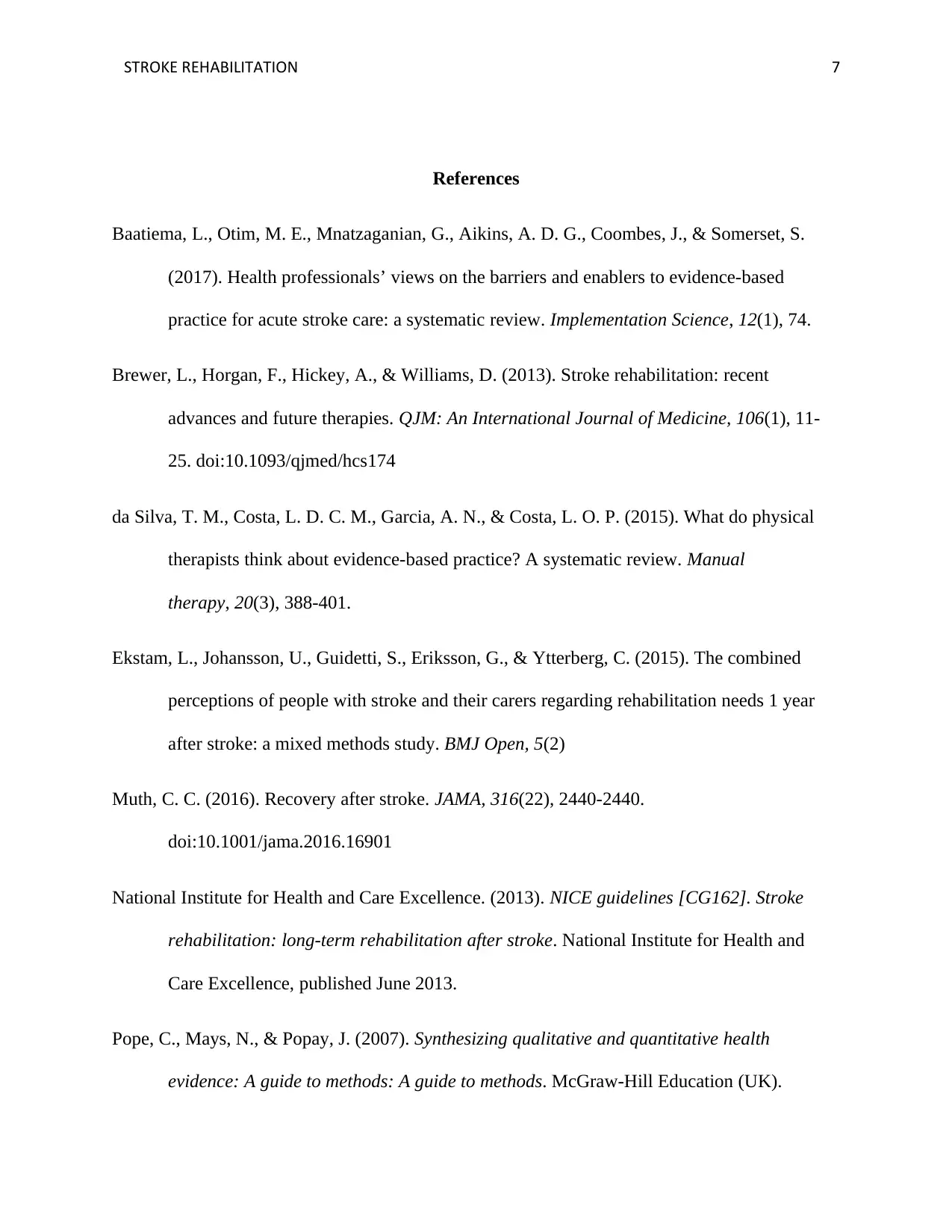
STROKE REHABILITATION 7
References
Baatiema, L., Otim, M. E., Mnatzaganian, G., Aikins, A. D. G., Coombes, J., & Somerset, S.
(2017). Health professionals’ views on the barriers and enablers to evidence-based
practice for acute stroke care: a systematic review. Implementation Science, 12(1), 74.
Brewer, L., Horgan, F., Hickey, A., & Williams, D. (2013). Stroke rehabilitation: recent
advances and future therapies. QJM: An International Journal of Medicine, 106(1), 11-
25. doi:10.1093/qjmed/hcs174
da Silva, T. M., Costa, L. D. C. M., Garcia, A. N., & Costa, L. O. P. (2015). What do physical
therapists think about evidence-based practice? A systematic review. Manual
therapy, 20(3), 388-401.
Ekstam, L., Johansson, U., Guidetti, S., Eriksson, G., & Ytterberg, C. (2015). The combined
perceptions of people with stroke and their carers regarding rehabilitation needs 1 year
after stroke: a mixed methods study. BMJ Open, 5(2)
Muth, C. C. (2016). Recovery after stroke. JAMA, 316(22), 2440-2440.
doi:10.1001/jama.2016.16901
National Institute for Health and Care Excellence. (2013). NICE guidelines [CG162]. Stroke
rehabilitation: long-term rehabilitation after stroke. National Institute for Health and
Care Excellence, published June 2013.
Pope, C., Mays, N., & Popay, J. (2007). Synthesizing qualitative and quantitative health
evidence: A guide to methods: A guide to methods. McGraw-Hill Education (UK).
References
Baatiema, L., Otim, M. E., Mnatzaganian, G., Aikins, A. D. G., Coombes, J., & Somerset, S.
(2017). Health professionals’ views on the barriers and enablers to evidence-based
practice for acute stroke care: a systematic review. Implementation Science, 12(1), 74.
Brewer, L., Horgan, F., Hickey, A., & Williams, D. (2013). Stroke rehabilitation: recent
advances and future therapies. QJM: An International Journal of Medicine, 106(1), 11-
25. doi:10.1093/qjmed/hcs174
da Silva, T. M., Costa, L. D. C. M., Garcia, A. N., & Costa, L. O. P. (2015). What do physical
therapists think about evidence-based practice? A systematic review. Manual
therapy, 20(3), 388-401.
Ekstam, L., Johansson, U., Guidetti, S., Eriksson, G., & Ytterberg, C. (2015). The combined
perceptions of people with stroke and their carers regarding rehabilitation needs 1 year
after stroke: a mixed methods study. BMJ Open, 5(2)
Muth, C. C. (2016). Recovery after stroke. JAMA, 316(22), 2440-2440.
doi:10.1001/jama.2016.16901
National Institute for Health and Care Excellence. (2013). NICE guidelines [CG162]. Stroke
rehabilitation: long-term rehabilitation after stroke. National Institute for Health and
Care Excellence, published June 2013.
Pope, C., Mays, N., & Popay, J. (2007). Synthesizing qualitative and quantitative health
evidence: A guide to methods: A guide to methods. McGraw-Hill Education (UK).
Paraphrase This Document
Need a fresh take? Get an instant paraphrase of this document with our AI Paraphraser
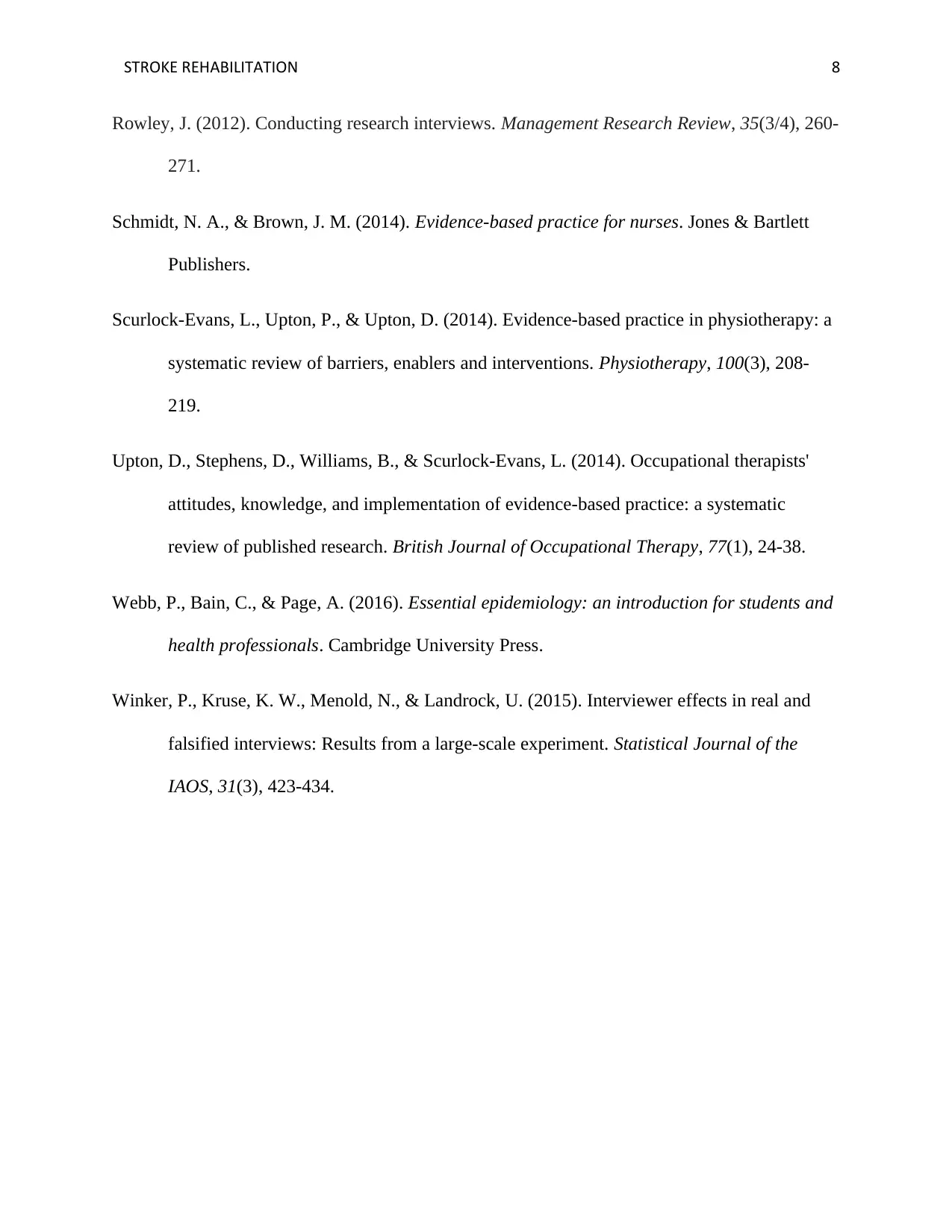
STROKE REHABILITATION 8
Rowley, J. (2012). Conducting research interviews. Management Research Review, 35(3/4), 260-
271.
Schmidt, N. A., & Brown, J. M. (2014). Evidence-based practice for nurses. Jones & Bartlett
Publishers.
Scurlock-Evans, L., Upton, P., & Upton, D. (2014). Evidence-based practice in physiotherapy: a
systematic review of barriers, enablers and interventions. Physiotherapy, 100(3), 208-
219.
Upton, D., Stephens, D., Williams, B., & Scurlock-Evans, L. (2014). Occupational therapists'
attitudes, knowledge, and implementation of evidence-based practice: a systematic
review of published research. British Journal of Occupational Therapy, 77(1), 24-38.
Webb, P., Bain, C., & Page, A. (2016). Essential epidemiology: an introduction for students and
health professionals. Cambridge University Press.
Winker, P., Kruse, K. W., Menold, N., & Landrock, U. (2015). Interviewer effects in real and
falsified interviews: Results from a large-scale experiment. Statistical Journal of the
IAOS, 31(3), 423-434.
Rowley, J. (2012). Conducting research interviews. Management Research Review, 35(3/4), 260-
271.
Schmidt, N. A., & Brown, J. M. (2014). Evidence-based practice for nurses. Jones & Bartlett
Publishers.
Scurlock-Evans, L., Upton, P., & Upton, D. (2014). Evidence-based practice in physiotherapy: a
systematic review of barriers, enablers and interventions. Physiotherapy, 100(3), 208-
219.
Upton, D., Stephens, D., Williams, B., & Scurlock-Evans, L. (2014). Occupational therapists'
attitudes, knowledge, and implementation of evidence-based practice: a systematic
review of published research. British Journal of Occupational Therapy, 77(1), 24-38.
Webb, P., Bain, C., & Page, A. (2016). Essential epidemiology: an introduction for students and
health professionals. Cambridge University Press.
Winker, P., Kruse, K. W., Menold, N., & Landrock, U. (2015). Interviewer effects in real and
falsified interviews: Results from a large-scale experiment. Statistical Journal of the
IAOS, 31(3), 423-434.
1 out of 8
Related Documents
Your All-in-One AI-Powered Toolkit for Academic Success.
+13062052269
info@desklib.com
Available 24*7 on WhatsApp / Email
![[object Object]](/_next/static/media/star-bottom.7253800d.svg)
Unlock your academic potential
Copyright © 2020–2025 A2Z Services. All Rights Reserved. Developed and managed by ZUCOL.





